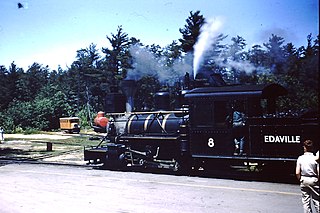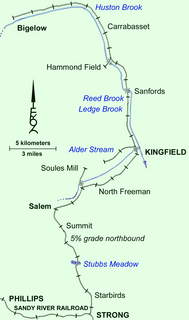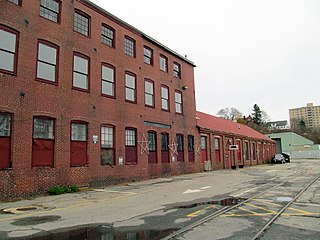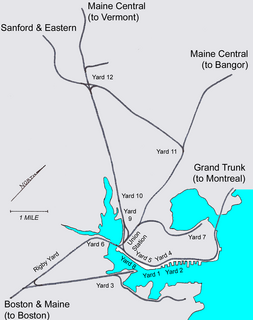Related Research Articles

The St. Lawrence and Atlantic Railroad, known as St-Laurent et Atlantique Quebec in Canada, is a short-line railway operating between Portland, Maine, on the Atlantic Ocean, and Montreal, Quebec, on the St. Lawrence River. It crosses the Canada–US border at Norton, Vermont, and Stanhope, Quebec, and is owned by short-line operator Genesee & Wyoming.

The Maine Central Railroad Company was a former U. S. Class I railroad in central and southern Maine. It was chartered in 1856 and began operations in 1862. By 1884, Maine Central was the longest railroad in New England. Maine Central had expanded to 1,358 miles (2,185 km) when the United States Railroad Administration assumed control in 1917. The main line extended from South Portland, Maine, east to the Canada–United States border with New Brunswick, and a Mountain Division extended west from Portland to Vermont and north into Quebec. The main line was double track from South Portland to Royal Junction, where it split into a "lower road" through Brunswick and Augusta and a "back road" through Lewiston which converged at Waterville into single track to Bangor and points east. Branch lines served the industrial center of Rumford, a resort hotel on Moosehead Lake, and coastal communities from Bath to Eastport.

The Wiscasset, Waterville and Farmington Railway is a 2 ft narrow gauge railway. The line was operated as a for-profit company from 1895 until 1933 between the Maine towns of Wiscasset, Albion, and Winslow, but was abandoned in 1936. Today, about two miles (3.2 km) of the track in the town of Alna has been rebuilt and is operated by the non-profit Wiscasset, Waterville and Farmington Railway Museum as a heritage railroad offering passenger excursion trains and hauling occasional cargo.

The Bridgton and Saco River Railroad (B&SR) was a 2 ft narrow gauge railroad that operated in the vicinity of Bridgton and Harrison, Maine. It connected with the Portland and Ogdensburg Railroad from Portland, Maine, to St. Johnsbury, Vermont, near the town of Hiram on the Saco River.

The Monson Railroad was a 2 ft narrow gauge railway, which operated between Monson Junction on the Bangor and Aroostook Railroad and Monson, Maine. The primary purpose of this railroad was to serve several slate mines and finishing houses in Monson. According to the Scientific American of 17 May 1890, it was the smallest railroad in the United States.
The Kennebec Central Railroad was a 2 ft narrow gauge railroad operating between Randolph and Togus, Maine. The railroad was built to offer transportation for American Civil War veterans living at Togus to the nearby City of Gardiner. Tracks of 25-pound steel rails ran five miles from Randolph, Maine to the veterans home at Togus. Train service began on 23 July 1890.

The Belfast & Moosehead Lake Railroad was a standard-gauge shortline railroad that operated from 1871 to 2007 over a single-track grade from Belfast to Burnham Junction in Maine.

The Sandy River Railroad was a 2 ft narrow gauge railway built to serve the towns of Strong and Phillips in the Sandy River valley upstream of Farmington. The Sandy River Railroad was the first narrow gauge common carrier railroad built in the State of Maine.

The Franklin and Megantic Railway (F&M) was a 2 ft narrow gauge railway in northern Maine that branches off from the Sandy River Railroad (SRR) at Strong and served sawmills in Salem township and in the town of Kingfield.
The Phillips and Rangeley Railroad was a 2 ft narrow gauge common carrier railroad in the State of Maine.

The Portland Company was established 10 November 1846 by John A. Poor and Norris Locomotive Works engineer Septimus Norris as a locomotive foundry to build railroad equipment for the adjacent Portland terminus of the Atlantic and St. Lawrence Railroad connection between Portland, Maine and Montreal. The shops opened for business in October, 1847. Its first locomotive, the Augusta, emerged from the shops in July 1848 for delivery to the Portland, Saco & Portsmouth. Over the next several decades, the Company produced in its Fore Street facilities over 600 steam locomotives as well as 160 merchant and naval vessels, railcars, construction equipment, Knox automobiles, and the like. Portland Company built the engines of the civil war side-wheel gunboats Agawam and Pontoosuc. Taking into account its other products, the Company could lay claim to being one of the leading medium-to-heavy steel manufacturers in New England. The company ceased production in 1978.

The Portland Terminal Company was a terminal railroad notable for its control of switching (shunting) activity for the Maine Central Railroad (MEC) and Boston & Maine (B&M) railroads in the Maine cities of Portland, South Portland, and Westbrook.

The Mountain Division is a railroad line that was once owned and operated by the Maine Central Railroad (MEC). It stretches from Portland, Maine on the Atlantic Ocean, through the Western Maine Mountains and White Mountains of New Hampshire, ending at St. Johnsbury, Vermont in the Northeast Kingdom. The line was abandoned in 1983 by MEC's successor, Guilford Transportation Industries (GTI). Guilford retained a stub between Portland and Westbrook. A section in New Hampshire remains in use by heritage railway Conway Scenic Railroad.

The Rockland Branch is a railroad from Brunswick, Maine to Rockland, Maine. A charter was granted in 1849 to build a railway from the Portland and Kennebec Railroad on the west side of the Kennebec River to Rockland. Construction through the rocky headlands of the Atlantic coast proved more expensive than anticipated. The Knox and Lincoln Railroad commenced service to Rockland in 1871 using a ferry to cross the Kennebec River between Bath and Woolwich. The Knox and Lincoln was leased by Maine Central Railroad in 1891, and became Maine Central's Rockland Branch in 1901. Maine Central purchased the Samoset destination hotel in nearby Glen Cove in 1912, and offered direct passenger service for summer visitors from the large eastern cities. Carlton bridge was completed in 1927 to carry the railroad and U.S. Route 1 over the Kennebec River. Maine Central sold the Samoset hotel in 1941, and the last Maine Central passenger train to Rockland was on 4 April 1959. The State of Maine purchased the branch in 1987 to prevent abandonment. The line has subsequently been operated by the Maine Coast Railroad, the Maine Eastern Railroad, and, beginning in 2016, the Central Maine and Quebec Railway. In 2019, Canadian Pacific Railway agreed to purchase the Central Maine and Quebec, thereby inheriting the operation of the Rockland Branch.. The acquisition was completed on June 3, 2020.

The Somerset Railroad was built to serve Kennebec River communities and later extended through timberlands to a large wooden Victorian era destination hotel on Moosehead Lake. The railway became part of the Maine Central Railroad in 1911; and a portion remained in intermittent operation by Pan Am Railways until 2013.

The Pittsfield Railroad Station is a historic former railroad station at 114 Central Street in Pittsfield, Maine. The station was built in 1888 by the Maine Central Railroad, and now serves as the Depot House Museum, operated by the Pittsfield Historical Society. It is one of the best-preserved railroad stations in Maine from that time period. The building was listed on the National Register of Historic Places on January 23, 1980.
Maine Central Railroad began operating diesel locomotives in 1935, and had retired all steam locomotives by 1954. That time interval was a joint operating period with the Boston and Maine Railroad (B&M). This article describes diesel locomotives owned by Maine Central through the period of joint operation and later independent operation prior to Guilford Rail System control in 1981.
Maine Central Railroad constructed a Foxcroft Branch in two stages after completing its main line from Portland to Bangor. The Dexter and Newport Railroad was completed in 1868 northward from Newport Junction on the Maine Central main line to Dexter. The completed railroad was leased by the Maine Central the following year. An extension northward from Dexter to Foxcroft on the Piscataquis River was completed in 1889 as the Dexter and Piscataquis Railroad. The branch became a major pulpwood loading point through the 1970s; but was abandoned in 1990.
The Somerset and Kennebec Railroad was a 19th-century Maine railroad which became part of the Maine Central Railroad.

The Maine Central Railroad Company main line extended from Portland, Maine, east to the Canada–US border with New Brunswick at the Saint Croix-Vanceboro Railway Bridge. It is the transportation artery linking Maine cities to the national railway network. Sections of the main line had been built by predecessor railroads consolidated as the Maine Central in 1862 and extended to the Canada–US border in 1882. Through the early 20th century, the main line was double track from South Portland to Royal Junction, where it split into a lower road through Brunswick and Augusta and a back road through Lewiston which converged at Waterville into single track to Bangor and points east. Westbound trains typically used the lower road with lighter grades, while eastbound trains of empty cars used the back road. This historical description does not include changes following purchase of the Maine Central Railroad by Guilford Transportation Industries in 1981 and subsequent operation as part of Pan Am Railways.
References
- Marson, Don & Jennison, Brian (1999). Railroads of the Pine Tree State Volume 1. Four Ways West Publications. ISBN 1-885614-31-4.
- Moody, Linwood W. (1959). The Maine Two-Footers. Howell-North.
- Peters, Bradley L. (1976). Maine Central Railroad Company. Maine Central Railroad.